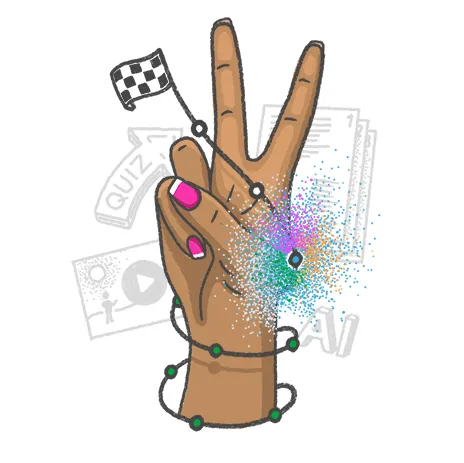Using a digital onboarding solution not only saves time for HR teams but also creates a consistent, personalized experience for every employee. In this guide, we’ll explore the benefits, best practices, process, and top software that can help you optimize your onboarding strategy.
What is digital onboarding?
Digital onboarding is the process of welcoming and integrating new employees using digital tools, software, and automated workflows. It replaces manual paperwork and fragmented training with an organized, online-first experience that can include:
- Automated document collection and e-signatures
- Virtual introductions and communication channels
- Online training modules and assessments
- Progress tracking and analytics
Unlike traditional onboarding, which can be inconsistent and time-consuming, digital onboarding software ensures every new hire receives the same high-quality experience—whether they work in the office, remotely, or in a hybrid setup.
Digital onboarding benefits for companies and employees
Implementing a digital onboarding solution offers advantages for both the organization and new hires:
- Faster time to productivity – employees get up to speed quickly thanks to structured training and easy access to resources.
- Consistency and compliance – all new hires receive the same information, reducing errors and missed steps.
- Higher engagement and retention – a positive onboarding experience encourages employees to stay longer.
- Better scalability – onboarding multiple hires or remote teams becomes easier and less resource-intensive.
- Improved tracking and reporting – managers can monitor progress and identify where extra support is needed.
Digital onboarding best practices
To get the most from your digital onboarding process, follow these best practices:
1. Start onboarding before day one
Send welcome messages, company materials, and login details in advance so new hires feel prepared.
2. Personalize the experience
Use your digital onboarding software to tailor training modules and content to the employee’s role, location, and department.
3. Combine automation with human touch - the blended learning approach
Automated workflows save time, but personal check-ins from managers or mentors build trust and relationships. A blended learning approach — where digital flexibility and structure meet human interaction — can be especially effective in onboarding, offering the best of both worlds. Read more about blended learning.
4. Provide clear milestones and goals
Set expectations for the first week, month, and quarter to help employees stay focused.
5. Gather feedback regularly
Ask new hires about their onboarding experience to refine and improve your process.
Digital onboarding process: step-by-step
A well-structured digital onboarding process typically includes:
- Preboarding – Send welcome packs, assign initial tasks, and share company policies digitally.
- First-day orientation – Use video calls, virtual tours, and interactive training to introduce the company culture and team members.
- Role-specific training – Provide relevant learning modules, hands-on assignments, and access to mentors.
- Ongoing support – Schedule regular check-ins and performance discussions.
- Evaluation and improvement – Review progress data and collect feedback for continuous improvement.
Choosing the right digital onboarding software or solution
When selecting a digital onboarding solution, consider:
- Ease of use – intuitive interfaces encourage adoption.
- Integration – the ability to connect with HR, payroll, and collaboration tools. Learnifier integrates seamlessly through its robust API.
- Customization – flexibility to match your company’s branding and processes.
- Analytics – reporting features to track engagement, completion rates, and knowledge retention.
- Scalability – capability to handle multiple hires at once.
Learnifier combines the structure and flexibility of a modern digital onboarding solution with powerful engagement tools, automation, and analytics — making it the ideal choice for organizations that want to scale onboarding without losing the human touch. Explore Learnifier’s onboarding features.
Top digital onboarding tools
Here are three key categories of tools that can strengthen your onboarding strategy:
1. HR software
An HR software can automate many of the administrative tasks in the onboarding process. These systems can:
• Manage documents: Digitally collect and store important documents, such as employment contracts and policies.
• Track progress: Keep track of each new employee’s progress through various phases of onboarding.
• Integrate with other tools: Seamlessly connect to other systems such as payroll and time management.
2. Communication platforms
Effective communication is key to successful onboarding. Tools like Slack or Microsoft Teams can:
• Facilitate team communication: Create channels specifically for new hires to share information and ask questions.
• Organize meetings: Easily schedule introductory meetings and regular check-ins.
• Share resources: Share important documents and links with new employees in a structured manner.
3. E-learning platforms
E-learning platforms are essential for delivering structured, engaging, and scalable onboarding training. They enable new hires to learn at their own pace while ensuring consistent quality across teams and locations.
• Customize training modules: Create tailored training programs to meet the company’s specific needs.
• Offer interactive courses: Include videos, quizzes, and practical exercises to make learning more engaging.
• Track training progress: Monitor how far each new hire has come in their training and certifications.
Final thoughts: Why digital onboarding is worth the investment
A well-planned digital onboarding process saves time, improves engagement, and ensures consistency across your organization. By following digital onboarding best practices and using the right digital onboarding software, you can create an experience that sets employees up for long-term success.






.webp)



.webp)









